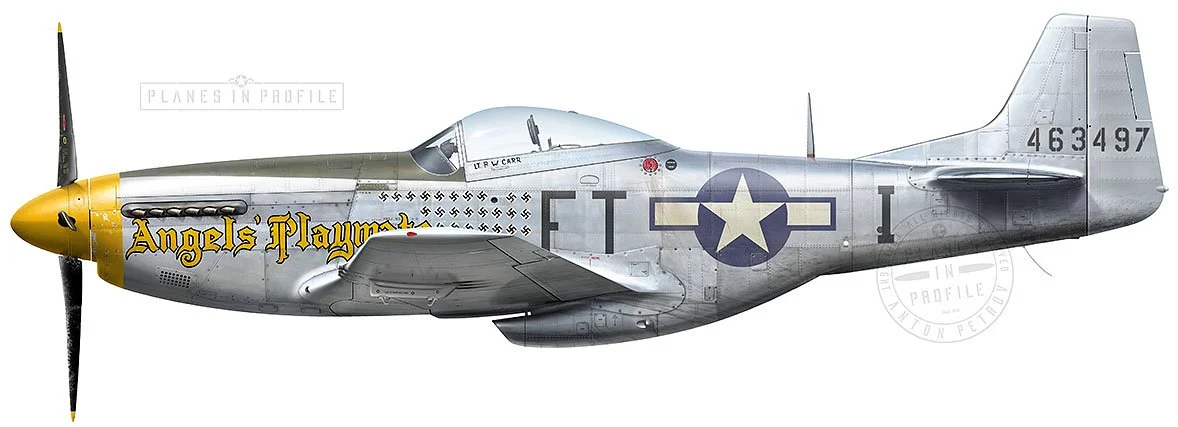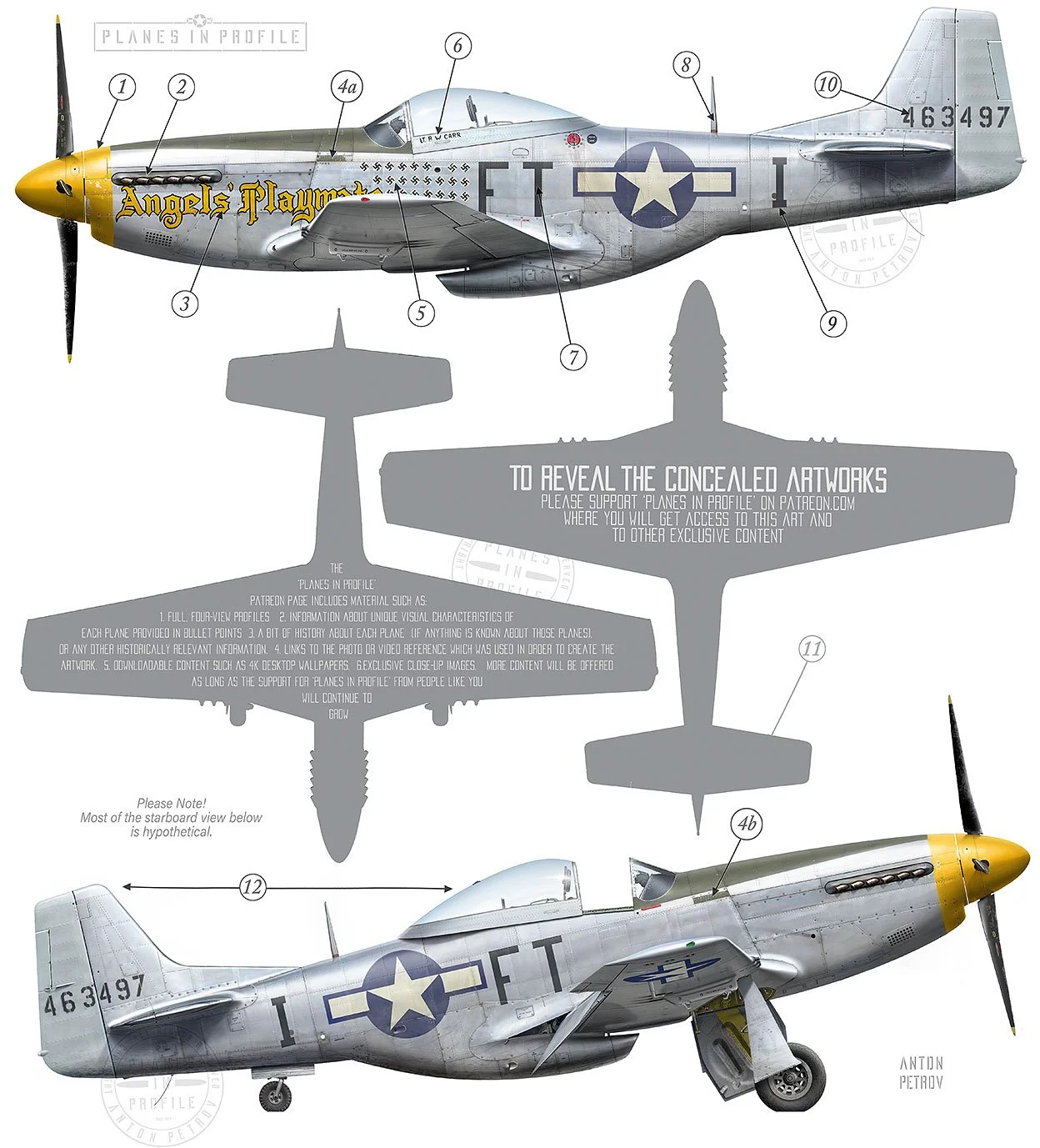Carr’s “Angels’ Playmate”
North American, P-51D-20NA (Mustang), Serial number 44-63497
353rd Fighter Squadron, 354th Fighter Group “Pioneer Mustang Group”, 9th Air Force,
Rosieres-en-Haye (France) (A-98), Ober Olm Airfield(Germany)(Y-64), Ansbach (Germany)(R-45), AAF Station Herzogenaurach (R-29)(Germany). March 1945 to End of the war.
Flown by Capt. Bruce Ward Carr (Peck’s Bad Boy)
44-63497 as it looked between April 3 -April 9, 1945. The illustration is based on this photo.
Bruce Carr began his war service as part of the 363rd FG and was responsible for his squadron’s first air victory which occurred on March 8th, 1944. However, instead of being celebrated for this effort he was accused by his superiors of being overly aggressive in the air. An insult to the young and budding fighter pilot. This created a rift between him and his superiors and gave Carr the reputation of being a ‘rebel’, earning himself the “Peck’s Bad Boy” nickname and culminating in Carr being put under arrest for insubordination and even scheduled to be court marshalled! Luckily for Carr, his predicament became known to Capt Glenn Eagleston of the 354th FG’s 353rd Squadron, who saw great potential in Carr and arranged for him to be transferred to Eagleston’s squadron in May, 1944. Eagleston’s foresight paid off when Carr became one of 354th top fighter aces, contributing 14 air victories (+3 unconfirmed), 1 probable, 2 damaged (+1 unconfirmed) and 11 strafing kills to the group’s victory board (other sources say 7.5 strafing kills).
Aiplane 44-63497 was the second ‘Angel’s Playmate’ Mustang assigned to Carr as part of the 353rd FS. He received it in March 1945 [1], when he returned from his thirty-day leave. This second ‘Angel’s Playmate’ was almost identical in external appearance to his first, but what makes the second more special is that Carr scored many of his victories while flying it (he didn’t score any flying his first Angels’Playmate), and all of his victories of the war were eventually displayed on the side of 63497’s fuselage.
The victories scored in 44-63497 were[2]:
Mar 16th 3 x Me-109 (Unconfirmed destroyed) 12 m NW of Limburg (Germany)
1 x Me-109 (Unconfirmed damaged) 12 m NW of Limburg (Germany)
Apr 1 0.5 x Ju-188 Wurzburg-Kassel area (Germany)
Apr 2 3 x FW-190 Kronach Bayreuth area (Germany)
2 x Me-109 Kronach Bayreuth area (Germany)
1 x Me-109 (damaged) Kronach Bayreuth area (Germany)
Further two, possibly scored while flying 44-63497 (though I was unable to confirm this):
Apr 10 1 x Me-109 Ehar area (Germany)
Apr 15 1 x He-111 Gotha (Germany)
The first 3 victories in Carr’s new Angels’ Playmate (scored on March 16th) were unconfirmed. On that day Carr encountered some 30 Me-109s while leading the 353rd FS on a sweep north-west of Limburg. Carr’s flight engaged in a big dogfight with the enemy at around 16,000 feet and resulted in them claiming nine Me-109s [3]. Carr claimed three, but was credited with none.
The most notable air battle while flying 44-63497, and arguably Carr’s greatest feat, occurred on April 2nd, 1945 when Carr became an ace in one day. On that occasion, while leading a fighter sweep, Carr encountered a gaggle of sixty drop tank-laden Me-109 and FW-190 fighters, 8 miles northwest of Nuremberg, headed west. Carr’s group pounced on the enemy formation with guns blazing and before the Germans could recover, seven of their fighters were shot out of the sky. Flying Angel’s Playmate, Carr was credited with 5 kills and 1 damaged. Here is how he described the combat:
”It was really a piece of cake. They were in two circles when we hit them, and they seemed to sit there while I fired away. Of course there were times during the combat that I had enemy aircraft on my tail while I was attacking, but fortunately they were poor shots”. [4]
It’s worth noting that Carr was the last pilot in the ETO to achieve the ‘ace in one day’ feat.
I was unable to confirm if the remaining victories were scored while flying Angels’ Playmate, but they were scored during the time while this plane was assigned to Carr.
The Me-109 destroyed on April 10th was when Carr caught an Me-109 which had barely taken off at the Kirchenlarbach aerodrome. Carr fired a short burst and sent the Me-109 falling back to the ground.
The He-111 destroyed on April 15th was when Carr caught a He-111 trying to land at Mensdorph aerodrome and shot the enemy down. Carr also destroyed two flack positions on this airfield before he departed.
In addition to these, Carr also destroyed a FW-190 and a Ju-88 on the ground during a strafing mission on April 25th. [5]
44-63497 as it looked soon after April 15th, 1945. Note the two extra victories s(cored in mid-April) were added to the front of the “victories display”. The illustration is based on this photo.
Both Carr and Angel’s Playmate survived the war. Angels’ Playmate was later exhibited at the USSTAF Military Equipment Exhibition which took place under the Eiffel Tower in Paris, in August 1945.
Noteworthy Visual Characteristics
44-63497 as it appeared between April 3rd and April 9th, 1945, while stationed at Rosieres-en-Haye (France) (A-98) and Ober Olm Airfield (Germany)(Y-64).
1) Yellow colour (appearing on the nose) was the identification colour 353rd Fighter Squadron within the of 354th FG.
2) The exhaust stack shroud appears to be quite dark in most photos of this plane and especially in the later photos, such as this one. It’s probably because this part of the plane was covered with soot/rust, especially as the plane became older. But there might even be a chance that this part was even painted a darker colour?
3) “Angel’s Playmate” was the name Bruce Carr gave to his first assigned Mustang, a P-51D-5NA, serial number 44-13693.
The story has it that Carr had never flown above 10,000 feet (3,000 m) before his unit received P-51 Mustangs. Once equipped with a Mustang, Carr took it to an altitude of 30,000 feet (9,100 m) and was very impressed with its performance so high up in the heavens, inspiring him to name the plane “Angels’ Playmate”. His second Mustang (the plane featured on this page) inherited the same name.
4a & 4b) Note a plate painted in a darker colour, presumably on both sides of the plane (the plate on the starboard site is dark in the the photo of the plane from summer of 1945).
5) The 23 black swastikas over a white circle represent Carrs victory count between April 3rd and April 9th, 1945. These represent all of Carr’s aerial victories, including probable and damaged.
On April 10th and April 15th Bruce Carr scored two more aerial victories which were added as two extra swastikas.
6) The pilot’s name “Lt. B.W.Carr” appeared on the canopy frame.
7) “FT” was the letter code of the 353rd Fighter Squadron.
8) The antenna mast appears to be slightly darker than the metallic fuselage in some photos. There could be a chance that it was painted (yellow?), but what’s more likely is that it was metallic and simply reflected the light at a different angle to the fuselage, this appearing a bit darker.
9) “I” was the identification code of Carr’s Mustang. His first Mustang, which was also named Angels’ Playmate, also had the code “I”.
10) 463497 represents the plane’s serial number 44-63497
11) The identification stripes appeared only on the horizontal stabilisers/elevators and not on the wings.
12) It looks like there was no antenna wire.
At the exhibition in Paris, summer of 1945.
1) The nose of the plane (at least) was retouched with paint for the exhibition.
2) The plane at the exhibition was equipped with anti-personnel fragmentation bomb clusters.
3a & b) Bruce Carr’s name was repainted and appeared on both sides of the airplane. He was promoted to Captain on April 9th, 1945, so the new inscriptions showed Capt. BRUCE W. CARR.
There was a further inscription under B/Carr’s name on both sides of the plane. These were most likely the names of the ground crew and the Crew Chief.
4) During the exhibition there was something painted on the starboard side nose of the airplane. I wasn’t able to find out what that was (possibly some sort of a diagram?).
FOOTNOTES
[1] Based on the information from the book ‘354th Fighter Group’, by William N. Hess, published by Osprey Publishing in 2002, pages 126, PDF e-book ISBN:978 1 78200 894 1
[2] Information about Carr’s victories is based on the book by Frank Olynyk called “Stars & Bars”, published by Grub Street in 1995, p.184.
[3] Based on the information from the book ‘354th Fighter Group’, by William N. Hess, published by Osprey Publishing in 2002, pages 111, PDF e-book ISBN:978 1 78200 894 1
[4] ‘354th Fighter Group’, by William N. Hess, published by Osprey Publishing in 2002, pages 116, PDF e-book ISBN:978 1 78200 894 1
[5] Information about he four victory in this paragraph is from ‘P-51 Mustang Aces’, by William N. Hess and Thomas G.Ivie, published by Motorbooks International in 1992, page 126, ISBN 0-87938-530-8
SUMMARY OF LINKS TO THE REFERENCE IMAGES AND/or VIDEOS
https://cdn.historycollection.com/wp-content/uploads/2020/09/27bruce-carrs-p-51-at-wars-end.-pme.jpg
http://www.clankerr.org/uploads/4/3/2/2/43224613/354carr300_orig.jpg
https://youtu.be/mF4miX9g7ZM?t=369
After April 15th, 1945
https://upload.wikimedia.org/wikipedia/commons/b/b5/P51angelsplaymate.jpg
https://ww2aircraft.net/forum/attachments/1615724384454-png.616026/
After the war, at the exhibition in Paris, August 1945.
https://i0.wp.com/skylighters.org/wp-content/uploads/2022/01/Angels-Playmate.jpg?w=2048&ssl=1
The video of the exhibition can be found on this page https://www.dailymotion.com/video/x72jqng
Angels’ Playmate appears at 9:00, 10:00, 16:08, 19:22, 22:52
All the work presented on this page is subject to updates and revisions in the light of new information which might present itself. If you have any new information relevant to this page or disagree with anything that's presented here, then please contact me through the Planes in Profile Facebook page to help make the content of this page more accurate. Thanks:)




